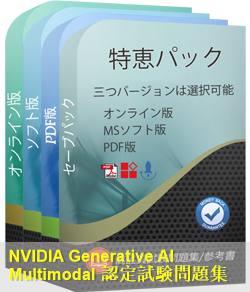NCA-GENM試験の品質と価値
JPNTestのNVIDIA-Certified Associate NCA-GENM模擬試験問題集は、認定された対象分野の専門家と公開された作成者のみを使用して、最高の技術精度標準に沿って作成されています。
JPNTestでNVIDIA NCA-GENM問題集をチョイスする理由
JPNTestは、1週間で完璧に認定試験を準備することができる、忙しい受験者に最適な問題集を提供しております。 NCA-GENMの問題集は、NVIDIAの専門家チームがベンダーの推奨する授業要綱を深く分析して作成されました。弊社のNCA-GENM学習材料を一回のみ使用するだけで、NVIDIA認証試験に合格することができます。
NCA-GENMはNVIDIAの重要な認証であり、あなたの専門スキルを試す認定でもあります。受験者は、試験を通じて自分の能力を証明したいと考えています。 JPNTest NVIDIA Generative AI Multimodal は、NVIDIA-Certified Associateの403の問題と回答を収集して作成しました。NVIDIA Generative AI Multimodalの知識ポイントをカバーし、候補者の能力を強化するように設計されています。 JPNTest NCA-GENM受験問題集を使用すると、NVIDIA Generative AI Multimodalに簡単に合格し、NVIDIA認定を取得して、NVIDIAとしてのキャリアをさらに歩むことができます。
あなたのNCA-GENM試験合格を100%保証
JPNTestテスト問題集を初めて使用したときにNVIDIA-Certified Associate NCA-GENM試験(NVIDIA Generative AI Multimodal)に合格されなかった場合は、購入料金を全額ご返金いたします。
NCA-GENMの迅速なアップデート対応
NCA-GENM試験に変更がございました場合は、現在の試験と一致するよう、瞬時に学習資料を更新することができます。弊社は、お客様に最高、最新のNVIDIA NCA-GENM問題集を提供することに専念しています。なお、ご購入いただいた製品は365日間無料でアップデートされます。
ダウンロード可能なインタラクティブNCA-GENMテストエンジン
NVIDIA-Certified Associateの基礎準備資料問題集には、NVIDIA-Certified Associate NCA-GENM試験を受けるために必要なすべての材料が含まれています。詳細は、正確で論理的なものを作成するために業界の経験を常に使用しているNVIDIA-Certified Associate によって研究と構成されています。
NVIDIA Generative AI Multimodal 認定 NCA-GENM 試験問題:
1. Which of the following techniques are commonly used to address the 'hallucination' problem in generative A1 models, where the model generates content that is factually incorrect or nonsensical? (Select all that apply)
A) Implementing retrieval-augmented generation (RAG), where the model consults an external knowledge source before generating content.
B) Increasing the model size and training dataset.
C) Employing adversarial training techniques to improve the model's robustness to noisy input data.
D) Lowering the temperature parameter during decoding to encourage more conservative and predictable outputs.
E) Using Reinforcement Learning from Human Feedback (RLHF) to align the model's output with human preferences and factual correctness.
2. You have trained a multimodal model for visual question answering (VQA). During inference, the model often generates incorrect answers even though it seems to understand the question and the image content. Which of the following strategies could help improve the accuracy of the model's predictions? (Select all that apply)
A) Use beam search decoding to explore multiple possible answer sequences.
B) Reduce the size of the training dataset.
C) Apply data augmentation techniques to the training images, such as random cropping and rotations.
D) Increase the learning rate during fine-tuning.
E) Implement a loss function that penalizes incorrect answers more heavily.
3. In the context of multimodal data analysis, which of the following statements accurately describe the challenges associated with data alignment?
A) Data alignment ensures that data from different modalities refers to the same event or entity.
B) Misalignment can lead to spurious correlations and reduced model performance.
C) Data alignment is not relevant when using deep learning models.
D) Perfect data alignment is always achievable with proper preprocessing techniques.
E) Data alignment is only necessary when dealing with time-series data.
4. You are training a multimodal generative A1 model for image captioning. After initial training, you observe that the model excels at describing common objects but struggles with nuanced details and rare objects. Which of the following performance optimization strategies would be MOST effective in addressing this issue?
A) Apply early stopping to prevent overfitting to the common objects.
B) Increase the batch size during training to improve GPU utilization.
C) Increase the number of layers in the encoder network.
D) Reduce the learning rate to fine-tune the model on the existing dataset.
E) Implement a custom loss function that penalizes inaccuracies in describing rare objects more heavily.
5. Which of the following are key architectural features of a U-Net that make it suitable for image generation tasks, particularly when starting from pure noise?
A) A bottleneck layer that compresses the encoded information.
B) A fully connected layer at the end for classification.
C) Use of convolutional layers in both encoder and decoder paths.
D) Skip connections between corresponding encoder and decoder layers.
E) Progressive upsampling in the decoder path to reconstruct the image.
質問と回答:
| 質問 # 1 正解: A、D、E | 質問 # 2 正解: A、C、E | 質問 # 3 正解: A、B | 質問 # 4 正解: E | 質問 # 5 正解: A、C、D、E |


 5 お客様のコメント
5 お客様のコメント





